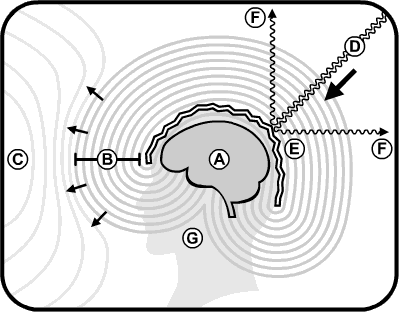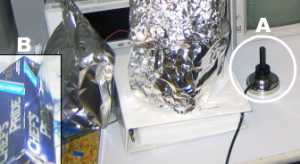Ha!
From MIT via Intel Research:
Ali Rahimi1, Ben Recht 2, Jason Taylor 2, Noah Vawter 2
17 Feb 2005
1: Electrical Engineering and Computer Science department, MIT.
2: Media Laboratory, MIT.
 |
Abstract
Introduction
It has long been suspected that the government has been using satellites to read and control the minds of certain citizens. The use of aluminum helmets has been a common guerrilla tactic against the government's invasive tactics [1]. Surprisingly, these helmets can in fact help the government spy on citizens by amplifying certain key frequency ranges reserved for government use. In addition, none of the three helmets we analyzed provided significant attenuation to most frequency bands. We describe our experimental setup, report our results, and conclude with a few design guidelines for constructing more effective helmets.Experimental Setup
| The Classical | ||
| The Centurion |
The Fez
We evaluated the performance of three different helmet designs, commonly referred to as the Classical, the Fez, and the Centurion. These designs are portrayed in Figure 1. The helmets were made of Reynolds aluminium foil. As per best practices, all three designs were constructed with the double layering technique described elsewhere [2].
A radio-frequency test signal sweeping the ranges from 10 Khz to 3 Ghz was generated using an omnidirectional antenna attached to the Agilent 8714ET's signal generator....
RebuttalFrom ZPi:...Results
For all helmets, we noticed a 30 db amplification at 2.6 Ghz and a 20 db amplification at 1.2 Ghz, regardless of the position of the antenna on the cranium. In addition, all helmets exhibited a marked 20 db attenuation at around 1.5 Ghz, with no significant attenuation beyond 10 db anywhere else.
Conclusion
The helmets amplify frequency bands that coincide with those allocated to the US government between 1.2 Ghz and 1.4 Ghz. According to the FCC, These bands are supposedly reserved for ''radio location'' (ie, GPS), and other communications with satellites (see, for example, [3]). The 2.6 Ghz band coincides with mobile phone technology. Though not affiliated by government, these bands are at the hands of multinational corporations.
It requires no stretch of the imagination to conclude that the current helmet craze is likely to have been propagated by the Government, possibly with the involvement of the FCC. We hope this report will encourage the paranoid community to develop improved helmet designs to avoid falling prey to these shortcomings.
A recent MIT study [1] calls into question the effectiveness of Aluminum Foil Deflector Beanies. However, there are serious flaws in this study, not the least of which is a complete mischaracterization of the process of psychotronic mind control. I theorize that the study is, in fact, NWO propaganda designed to spread FUD against deflector beanie technology, and aluminum shielding in general, in order to disembeanie paranoids, leaving them open to mind control.
First and foremost, Rahimi et al. only considered simple radio frequencies. As I explained in detail in chapter 4 ("Psychotronic and AFDB Theory") of my book [2], only psychotronic energy can affect the brain in any coherent manner. Simple EM fields have only trivial effects -- such as causing indistinct sensations of a supernatural presence [3] -- over short distances. Only by converting electromagnetic energy into psychotronic energy using a psychotron-based device can the forces of mind control access from afar the neural network of a brain to both implant and extract thought complexes.
As illustrated in Figure 1, unlike with the mere attenuation of EM fields, aluminum deflects psychotronic fields and coherent psychotronic rays. The operational modalities of AFDBs for EM and psychotronic energies are completely different, and thus the experiment conducted by Rahimi et al. is inappropriate to test the effectiveness of deflector beanie technology in stopping mind control.
FIGURE 1: An AFDB-covered brain (A) is shielded by a repulsive resonance buffer (B), which deflects psychotronic fields (C). Coherent psychotronic rays (D) are defected at the aluminum surface (E) and decoherently scattered (F). The resonance buffer encapsulates the brain (G), providing basal protection against fields and glancing rays.
Besides the experiment's unsuitability, the experimental procedures themselves appear flawed. The measuring of the signal was described by Rahimi et al. as follows:
The receiver antenna was placed at various places on the cranium of 4 different subjects: the frontal, occipital and parietal lobes. Once with the helmet off and once with the helmet on.But the antenna shown in Figure 2 on their site would not possibly be able to fit under the helmets while on a head, at least not without awkwardly balancing the helmet counter to best practices or puncturing the foil. If the antenna was instead placed on the outside of the helmets, as seems most likely from the description, then that calls into question the entire conclusion: If the amplification effect is measured only on the helmet outside, then that suggests that the helmet is reflecting the EM radiation away from the wearer's brain.
FIGURE 2: (A) Excessively pointy omnidirectional antenna. (B) Chef's Pride brand foil (photo enhanced).
Oddly, Rahimi et al. make a great deal about the price of their equipment, noting the US$250,000 price tag of their Agilent 8714ET network analyser three times in their short paper. What relevance is this to the conclusion? I believe its a subtle way of discouraging people from replicating the experiment at home....MORE

